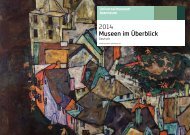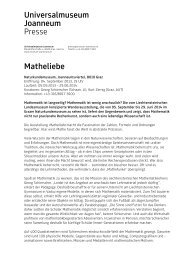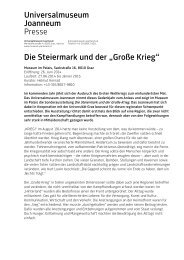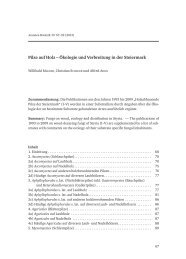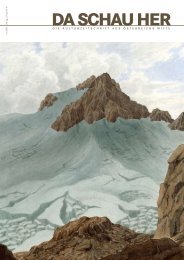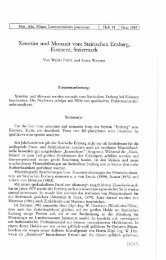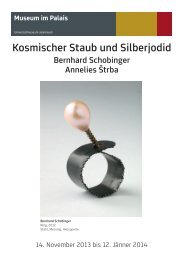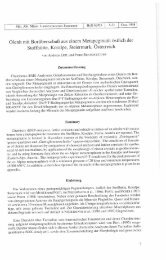Katalog/Catalogue - deutsch/englisch
Katalog/Catalogue - deutsch/englisch
Katalog/Catalogue - deutsch/englisch
Erfolgreiche ePaper selbst erstellen
Machen Sie aus Ihren PDF Publikationen ein blätterbares Flipbook mit unserer einzigartigen Google optimierten e-Paper Software.
Background her transkulturell, und auch die Ausdrucksmittel,<br />
derer sie sich bedienen, haben interkulturellen Charakter.<br />
Die an dieser Ausstellung teilnehmenden Künstler stammen zum<br />
überwiegenden Teil aus Japan und haben in anderen Ländern<br />
und Kontinenten Erfahrungen gesammelt: in Asien, Nordamerika,<br />
insbesondere in den USA, und in Afrika. Ihr Japanischsein ist das<br />
Maß ihrer Transkulturalität und umgekehrt – ihre Transkulturalität<br />
ergänzt die Dimension ihrer Nationalität. Erst aus dieser<br />
Perspektive gewinnt die Ausstellung an Bedeutung – wenn<br />
die heutzutage verbreiteten Probleme der Perzeption, der Zeit<br />
und der Erinnerung, in Verbindung mit den heftigen Veränderungen<br />
qualitativen und radikalen Charakters, die in der Kultur<br />
des gesamten Globus stattfinden, bei dem völligen Sich-Öffnen<br />
für andere Kulturen deutlich kulturspezifische Wesenszüge<br />
annehmen.<br />
Anmerkungen<br />
1 Donald Keene: Appreciations of Japanese Culture. Tokio, New York: Kodansha<br />
1971, S. 94.<br />
2 Toshihiko Izutsu: The Theory of Beauty in the Classical Aesthetics of Japan.<br />
Den Haag, Boston, London: Nijhoff 1981, S. 72.<br />
3 Masaharu Anesaki: Art, Life and Nature in Japan. Tokio 1973, Kapitel I.<br />
4 Essays in Idleness (The Tsurezuragusa of Kenko). Übers. von D. Keene.<br />
Tokio, New York: Columbia University Press 1967, S. 115.<br />
5 In Search of Japanese Beauty. Tokio 1977, S. 26–27.<br />
6 The Pillow Book of Sei Shonagon. Oxford 1967, S. 24.<br />
7 Ebda, S. 195.<br />
8 Keene, Appreciations of Japanese Culture, S. 22.<br />
9 Soshitsu Sen XV: Tea Life, Tea Mind. Tokio, New York, S. 30.<br />
10 Izutsu, The Theory of Beauty in the Classical Aesthetics of Japan, S. 52.<br />
11 Ebda, S. 56.<br />
12 Shozo Sato: The Art of Sumi-e. Appreciation, Techniques and Application.<br />
Tokio 1984, S. ix.<br />
13 Ebda.<br />
Krystyna Wilkoszewska 86 87<br />
which they express themselves are also intercultural in<br />
character.<br />
The majority of artists taking part in this exhibition are<br />
from Japan, but are familiar with other countries and<br />
continents: Asia, North America – in particular the USA<br />
and Africa. Their Japanese nature is a measure of the<br />
transculturalism and conversely their transcultural experience<br />
complements their national background. The<br />
present exhibition acquires a special significance when<br />
viewed from this perspective, for the widespread difficulties<br />
with perception, time and memory that are to be<br />
found today, in connection with the violent qualitative and<br />
radical changes that are taking place in cultures around<br />
the globe, take on clearly culturally specific characteristics<br />
when faced with a complete openness with regard<br />
to another culture.<br />
Notes<br />
1 Donald Keene: Appreciations of Japanese Culture. Tokyo, New York:<br />
Kodansha 1971, p. 94.<br />
2 Toshihiko Izutsu: The Theory of Beauty in the Classical Aesthetics<br />
of Japan. The Hague, Boston, London: Nijhoff 1981, p. 72.<br />
3 Masaharu Anesaki: Art, Life and Nature in Japan. Tokyo 1973, Chapter I.<br />
4 Essays in Idleness (The Tsurezuragusa of Kenko). Transl. by D. Keene.<br />
Tokyo, New York: Columbia University Press 1967, p. 115.<br />
5 In Search of Japanese Beauty. Tokyo 1977, p. 26–27.<br />
6 The Pillow Book of Sei Shonagon. Oxford 1967, p. 24.<br />
7 Ibid., p. 195.<br />
8 Keene, Appreciations of Japanese Culture, p. 22.<br />
9 Soshitsu Sen XV: Tea Life, Tea Mind. Tokyo, New York, p. 30.<br />
10 Izutsu, The Theory of Beauty in the Classical Aesthetics of<br />
Japan, p. 52.<br />
11 Ibid., p. 56.<br />
12 Shozo Sato: The Art of Sumi-e. Appreciation, Techniques and<br />
Application. Tokyo 1984, p. ix.<br />
13 Ibid.



